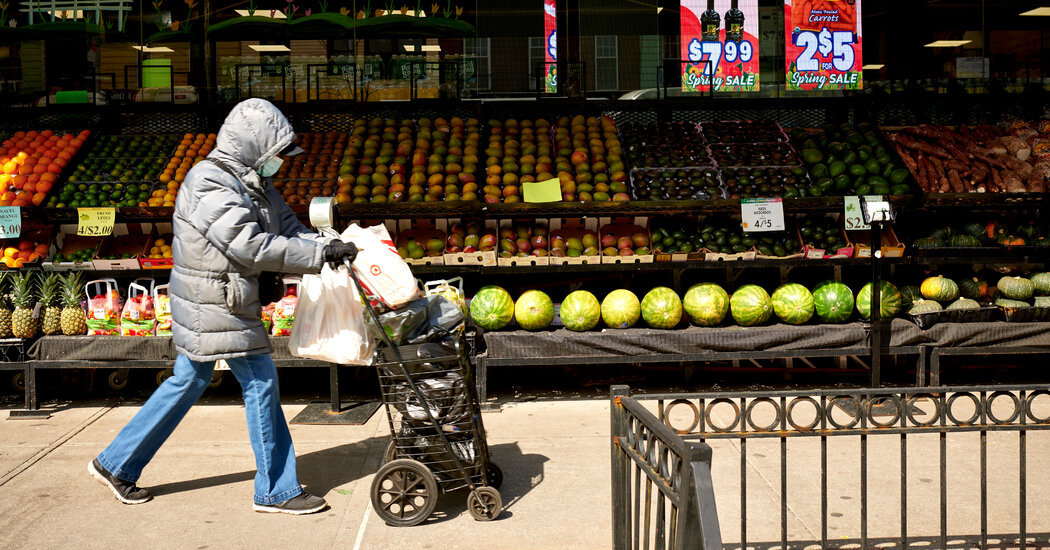
Americans built up trillions of dollars in savings during the pandemic. Now, with prices rising at their fastest pace in decades, they are tapping that stockpile to keep on spending.
Consumer spending rose 0.9 percent in April, the Commerce Department said on Friday, as Americans shook off high prices to buy tickets for flights, sports events and other experiences they had to forgo earlier in the pandemic. Auto sales also increased as car buyers snapped up vehicles after months of shortages.
Incomes are rising, too, the result of a robust job market and the fastest wage growth in decades. But incomes aren’t keeping up with spending, or with rising prices: After-tax income rose 0.3 percent in April from the prior month and was flat after accounting for inflation.
As a result, Americans are fueling their spending by saving less. Households set aside just 4.4 percent of their after-tax income last month, the lowest savings rate since 2008.
Record levels of government aid during the pandemic, combined with reduced spending on many leisure activities, allowed Americans to build up a substantial reserve of extra savings — $2.5 trillion or more by some estimates. That cushion could allow consumers to keep spending even as prices rise. A snapshot of Americans’ financial health conducted last fall and released by the Federal Reserve this week found that 78 percent of respondents felt they were “doing at least OK” — the highest rate in the survey’s nine-year history.
But relying on savings is unsustainable in the long run. Economists say many lower-income households have probably already exhausted their savings, or will in the months ahead, especially as high gas and food prices continue to take a toll. Balances of credit cards and similar types of debt rose at a 35.3 percent annual rate in March, the biggest one-month increase since 1998, according to data from the Federal Reserve.
“If you’re depending on the credit card to fund your spending, that’s by definition not sustainable,” said Tim Quinlan, a senior economist for Wells Fargo. Consumer spending has held up better than most forecasters expected, he said, but is likely to slow in the months ahead.
Understand Inflation and How It Impacts You
Consumers aren’t likely to get much relief from rising prices anytime soon. Inflation cooled slightly in April but remained close to a four-decade high.
Consumer prices rose 0.2 percent last month from March and were up 6.3 percent from a year earlier, the Commerce Department report showed. That was down from a 6.6 percent annual increase in March, which was the fastest pace of inflation since 1982.
Economists and investors closely watch the report’s Personal Consumption Expenditures price index, an alternative to the better-known Consumer Price Index, because the Fed prefers it as a measure of inflation. The central bank has been raising interest rates and has announced it will begin paring its assets in a bid to cool the economy and tame inflation.
In a statement released by the White House on Friday, President Biden called the dip in inflation “a sign of progress, even as we have more work to do.”
The slowdown in inflation in April was largely the result of a drop in the price of gasoline and other energy. Gas prices soared in February and March largely because of Russia’s invasion of Ukraine, then moderated somewhat in April. They have risen again in recent weeks, however, which could push measures of inflation back up in May. Food prices have also been rising quickly in recent months, a pattern that continued in April.
When the volatile food and fuel categories are stripped out, consumer prices were up 4.9 percent in April from a year earlier. That core measure, which some economists view as a more reliable guide to the underlying rate of inflation, was up 0.3 percent from a month earlier, little changed from the rate of increase in March.
The comparatively tame increase in core prices in the data released Friday stood in contrast to the sharp acceleration in the equivalent measure in the Consumer Price Index report released by the Labor Department this month. The divergence was mostly the result of differences in the way the two measures count airline fares, however, and economists said the Fed was unlikely to take much comfort from the Commerce Department data.
Inflation F.A.Q.
What is inflation? Inflation is a loss of purchasing power over time, meaning your dollar will not go as far tomorrow as it did today. It is typically expressed as the annual change in prices for everyday goods and services such as food, furniture, apparel, transportation and toys.
“My suspicion is they will probably look through the slowdown,” said Omair Sharif, the founder of the research firm Inflation Insights. He noted that the core index had also slowed in the fall, only to pick up again at the end of the year, catching the Fed off guard.
Many forecasters believe that the headline inflation rate peaked in March and that April marked the beginning of a gradual cool-down. But the recent rebound in gas prices threatens to complicate that picture. And even if inflation continues to ebb, prices are still rising far more quickly than the Fed’s target of 2 percent over time.
The public, Mr. Quinlan said, is unlikely to see the slight moderation in inflation as much to celebrate.
“To them, the year-over-year growth in prices doesn’t matter,” he said. “It’s: Why does a crappy lunch cost $12 now?”
Inflation has taken a toll on consumer sentiment, which fell 10.4 percent in May to its lowest level in more than a decade, according to a long-running survey from the University of Michigan. So far, however, that pessimism hasn’t translated into reduced spending.
“At least in the second quarter, consumers really had their purses wide open,” said Kathy Bostjancic, the chief U.S. economist at Oxford Economics. “We think eventually that’s going to have limits. Right now we’re all feeling pent-up and just need to travel. But come next year, it’s a different story.”
More spending has been moving toward experiences like hotel stays, concerts and haircuts in recent months as people have grown more comfortable in crowded spaces. Prices for goods have been rising faster than the cost of services, in part because of supply chain snarls and the war in Ukraine. Adjusted for inflation, goods spending rose 1 percent over the month, while services spending rose 0.5 percent.
That dynamic has rocked big-box stores like Walmart and Target, which have found themselves unable to pass along higher costs to shoppers. Stocks of discount retailers like Dollar Tree, by contrast, surged on Thursday as they reported sales increases and raised their earnings forecasts.




